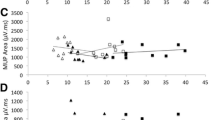Summary
The reliability of clinical examination of the tendon reflexes was examined by studying inter-observer agreement. Twenty patients were examined by three neurologists. The briskness of the tendon reflexes in arms and legs was scored on a nine-point scale. In 28% of the 160 examined reflexes the observations disagreed 2 scale units or more. Disagreement on the presence of asymmetry occurred in 45% of the 80 reflex pairs. In 15% one observer judged a reflex pair to be symmetrical while another observer found asymmetry of at least 2 scale units. In a second experiment clinical observation of apparently asymmetrical quadriceps reflexes was compared with measurement by surface electromyography. A significant, semi-logarithmic relationship was found between clinical scores and measured reflex amplitudes. Measured reflex asymmetry always agreed with clinical asymmetry, and the magnitudes of right-left amplitude differences were correlated with the magnitude of clinically observed asymmetry. The bedside examination of tendon reflexes is subject to considerable inter-observer disagreement.
Similar content being viewed by others
References
Bartko JJ (1966) The intraclass correlation coefficient as a measure of reliability. Psychol Rep 19:3–11
Bastron JA, Bickford RG, Brown JR, et al (Mayo Clinic Staff) (1956) Clinical examinations in neurology. Saunders, Philadelphia, p 188
Bathien N (1971) Reflexes spinaux chez l'homme et niveaux d'attention. Electroencephalogr Clin Neurophysiol 30:32–37
Clarke AM (1965) Relationship between the electromyogram and the force of the isometric reflex response of normal human subjects. Nature 208:551–552
Davis CM, Beaton R (1968) Facilitation and adaption of the human quadriceps stretch reflex produced by auditory stimulation. J Comp Physiol Psychol 65:483–487
Delwaide P J, Toulouse P (1981) Facilitation of monosynaptic reflexes by voluntary contraction of muscle in remote parts of the body. Mechanisms involved in the Jendrassik manoeuvre. Brain 104:701–719
Dietrichson P, Sorbye R (1971) Clinical method for electrical and mechanical recording of the mechanically and electrically elicited ankle reflex. Acta Neurol Scand 47:1–21
Emery FE (1931) The influence of mental activity on the height of the knee jerk. Am J Physiol 97:658–661
Fearing F (1930) Reflex action, a study in the history of physiological psychology. Williams and Wilkins: reprinted by MIT Press, Massachusetts, 1970
Fleiss JL (1981) Statistical methods for rates and proportions Wiley, New York
Gijn J van, Bonke B (1977) Interpretation of plantar reflexes: biasing effect of other signs and symptoms. J Neurol Neurosurg Psychiatry 40:787–789
Grossmann WI, Weiner H (1966) Some factors affecting the reliability of surface electromyography. Psychosom Med 28:78–83
Hoffmann P (1922) Untersuchungen über die Eigenreflexe (Sehnenreflexe) menschlicher Muskeln. Springer, Berlin
Hugon M (1973) Methodology of the Hoffman reflex in man. In: Desmedt JE (ed) New developments in electromyography and clinical neurophysiology, vol 3. Karger, Basel, pp 277–293
Koran ML (1975) The reliability of clinical methods, data and judgements; parts I and II. N Engl J Med 293:642–646, 695–701
Kramer MS, Feinstein AR (1981) Clinical biostatistics: the biostatistics of concordance. Clin Pharmacol Ther 29:111–123
Simons DG, Dimitrijevic MR (1972) Quantitative variations in the force of quadriceps responses to serial patellar taps in normal man. Am J Phys Med 51:240–263
Stam J, Crevel H van (1989) Measurement of tendon reflexes by surface electromyography in normal subjects. J Neurol 236:231–237
Stam J, Crevel H van (1989) Tendon reflex asymmetry by voluntary mental effort in healthy subjects. Arch Neurol 46:70–73
Stam J, Leeuwen JR van (1984) A simple measurement hammer for quantitative reflex studies. Electroencephalogr Clin Neurophysiol 58:282–284
Stam J, Tan KM (1987) Tendon reflex variability and method of stimulation. Electroencephalogr Clin Neurophysiol 67:463–467
Author information
Authors and Affiliations
Rights and permissions
About this article
Cite this article
Stam, J., van Crevel, H. Reliability of the clinical and electromyographic examination of tendon reflexes. J Neurol 237, 427–431 (1990). https://doi.org/10.1007/BF00314735
Received:
Revised:
Accepted:
Issue Date:
DOI: https://doi.org/10.1007/BF00314735




